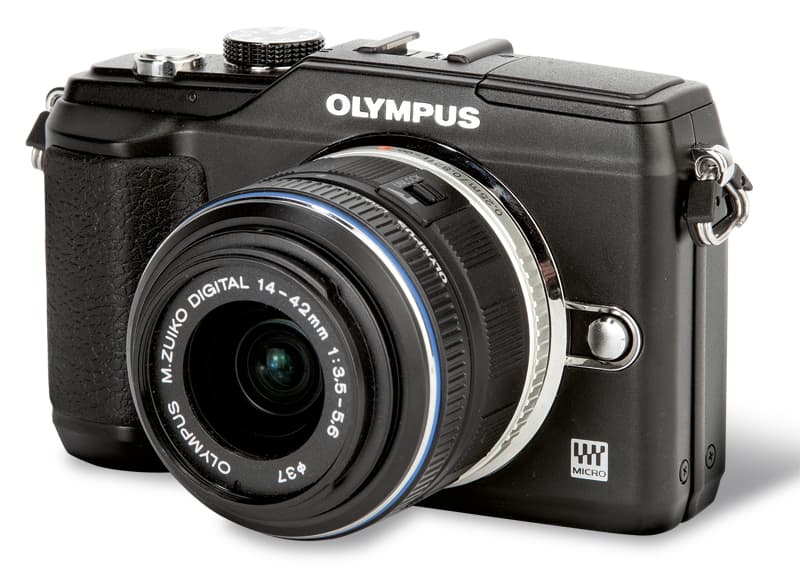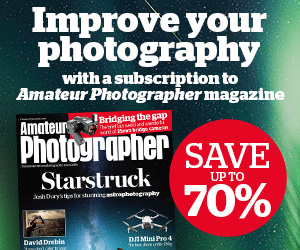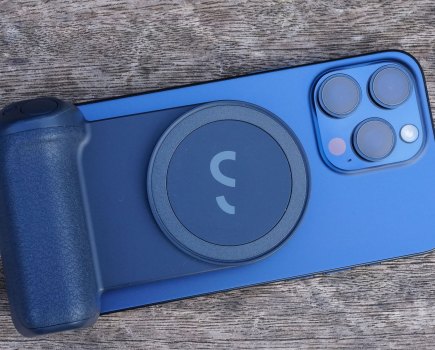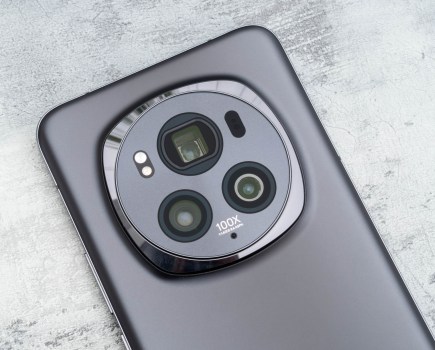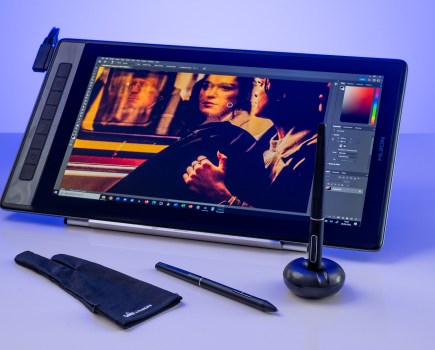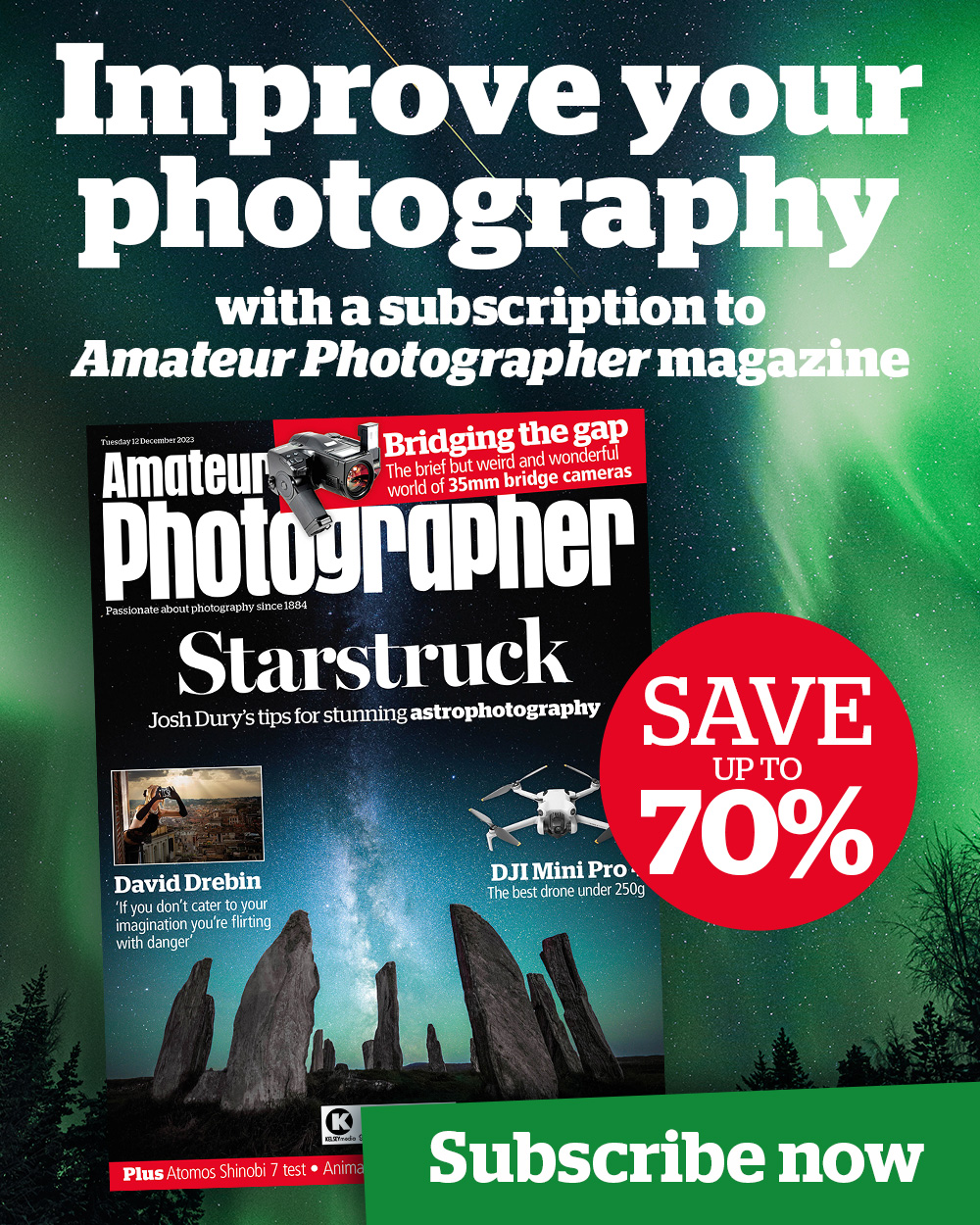Olympus Pen E-PL2 at a glance:
- 12.3-million-pixel micro four thirds Live MOS sensor
- ISO 200-6400
- Art filter image styles
- Hotshoe and accessory port
- 3in, 460,000-dot LCD screen
- Street price around £500, including 14-42mm f/3.5-5.6 kit lens
Olympus Pen E-PL2 review – Introduction
Aimed at entry-level photographers and photography enthusiasts, compact system cameras (CSC) are currently the biggest area of growth in the digital camera market. Smaller and lighter than a DSLR, these interchangeable-lens cameras appeal to people upgrading from a compact camera. They are also attractive to those people more used to a DSLR, but who are interested in a CSC as a secondary camera for when their bulkier DSLR is less convenient. This latest model, the Olympus Pen E-PL2, is perfectly placed to capture users at both ends of the market.
Announced at the Consumer Electronics Show (CES) in January, the Olympus Pen E-PL2 is an evolution of its predecessor, the E-PL1, which was released in February 2010. The new camera inherits many of the older model’s features, while updating a few others and adding some new ones of its own.
The Olympus Pen E-PL2 is designed as an entry-level camera, but it uses the same 12.3-million-pixel sensor as the E-P1 and E-P2, which sit above it in the Olympus Pen range. Like the E-PL1, the E-PL2 addresses an issue that afflicts both of the more expensive models: namely, that neither features a built-in flash. The small pop-up flash of the E-PL2 is an essential feature for photographers who are more used to the point-and-shoot approach.
For those using an interchangeable-lens camera for the first time, Olympus has kept the Live Guide that was originally introduced in the E-PL1. This on-screen display helps beginners to easily adjust the shooting settings. The camera also offers shooting tips, to help advise users on the basics of photographing different subjects.
Despite the E-PL2 being designed with entry-level users in mind, at its core is a range of manual exposure, focusing and colour options worthy of a DSLR, giving it a far broader appeal. With competition in this sector of the market becoming increasingly hot, it will be interesting to see exactly how the E-PL2 meets the demands of both groups of photographers.
Features
Like Olympus’s other micro four thirds cameras, the E-PL2 uses a 12.3-million-pixel, four thirds-sized Live MOS sensor. This sensor has been around in one form or another for about two years now, and the resolution is starting to look a little dated when compared to the current crop of APS-C-sized DSLR sensors that have 14, 16 and even 18-million-pixel resolutions.
Processing the information delivered by the sensor is the Olympus TruPic V image-processing system. This is also the same as that used in all other Olympus Pen cameras, but it is not as powerful as the TruPic V+ system used in the Olympus E-5 DSLR. Again like the other Pen-series cameras, the E-PL2 features in-camera sensor-shift image stabilisation, as well as a Supersonic Wave dust-reduction feature. Olympus has a long history in this field, being the first manufacturer to introduce dust reduction with the E-1 in 2003.
A more recent addition to the Olympus range is art filters. This applies dramatic image styles to photographs and has featured in the three previous Pen cameras, although they have been given a slight makeover for the E-PL2.The new camera is more than a cosmetic makeover of its predecessor, though, because while the core of the camera remains largely the same, there have been a number of significant improvements. A prime example is the slightly larger 3in LCD screen (only 2.7in on the E-PL1). Plus, macro and still-life photographers will be pleased with the addition of a USB socket, which allows the optional Olympus RM-UC1 cable release to be used.
The most interesting new features, however, are based around the E-PL2’s second-generation accessory port, positioned just below the flash hotshoe. On previous cameras the port has been used solely for the use of the VF-2 electronic viewfinder and the SEMA-1 microphone. But now joining these are two new items: the MAL-1 Macro Arm Light and the Penpal PP-1.
Of these two new devices the MAL-1 is probably of most interest, and again will be of particular appeal to still-life and macro photographers. The device consists of two flexible 17cm LED lamps that can be positioned to illuminate macro and close-up subjects. One of the best things about it is that the accessory port allows the device to be powered by the camera’s battery, so no additional power is required. It also helps to keep the Macro Arm Light small and lightweight.
The Penpal is a Bluetooth transmitter that allows you to send low-resolution images between a camera and a mobile phone or computer. The pictures, up to 2,600 of which can be stored on the Penpal’s internal memory, are automatically resized so they don’t take too long to send. The idea is that images can be quickly sent to a mobile phone or computer to be uploaded to a social networking site, or emailed. The Penpal is a nice idea, but I wonder how many people will really demand this immediacy when it is already possible to take five-million-pixel images on a mobile phone and upload it in seconds. Sadly, neither of the two new accessory port devices were available during our test of the camera.
Other improvements over the E-PL1 include an increased maximum shutter speed from 1/2000sec to 1/4000sec, and a raising of the maximum sensitivity by 1EV to ISO 6400. The lower end of the sensitivity range has also been adjusted, with the lowest setting now ISO 200 rather than ISO 100.
Features in use: Art filters

Olympus recently updated its in-camera art filters by introducing version II, previously found only in the Olympus E-5 DSLR. There are six in-camera art filters: pop art, soft focus, grainy film, pin hole, diorama and dramatic tone. Each of these applies a very different artistic style, which is previewed live on the rear LCD screen while the image is being taken.
If you are saving images as raw files, then art filters can be applied after the image has been captured, or using the Olympus editing software that comes bundled with the camera. Some of the filters also now have a few different variations. For example, there are two contrast settings for the grainy filter, and three different pin hole camera effects. A few of the effects even allow you to combine art filters: the pop art filter can be combined with the soft focus or pin hole filters.
Alternatively, a simple jagged white frame can be added around the images. Unfortunately, there is just the one type of frame available; it would have been nice to see a few variations, such as a jagged black border or a simple white border with a few different edge sizes. Hopefully, Olympus can include these in future art filters updates.
Whether the art filters are actually useful or not is open to debate. Some very interesting effects can be achieved, and it is certainly far quicker than applying them in editing software, but I doubt many of them will appeal to enthusiast photographers. The market for these types of effects is the same as those who use the Hipstamatic software on the Apple iPhone’s camera, namely people wanting a quick, interesting and quirky image. For this type of snapshot photographer, the art filters will certainly appeal, but there is still a lot of scope for mprovement.
Build and Handling
 Although the dimensions of the E-PL2 are roughly the same as that of the E-PL1, the new camera has been restyled to give it a sleek, understated look. Gone is the wide silver band that separates the aluminium front and plastic rear of the camera. Now the two materials are almost seamlessly joined. Also banished are the silver details across the front of the camera and the handgrip. Instead, the E-PL2 comes in a black, silver white or red finish, with silver around the metal lens mount and lens release button. Some may disagree but to my mind, and eye, the E-PL2 is the best-looking Olympus Pen to date.
Although the dimensions of the E-PL2 are roughly the same as that of the E-PL1, the new camera has been restyled to give it a sleek, understated look. Gone is the wide silver band that separates the aluminium front and plastic rear of the camera. Now the two materials are almost seamlessly joined. Also banished are the silver details across the front of the camera and the handgrip. Instead, the E-PL2 comes in a black, silver white or red finish, with silver around the metal lens mount and lens release button. Some may disagree but to my mind, and eye, the E-PL2 is the best-looking Olympus Pen to date.
However, it isn’t just the looks that have been improved on the E-PL2, as the handling is far better too. At the front of the camera there is a smoother, more contoured shape and a leather-effect plastic grip instead of the angular handgrip of the E-PL1.
The rear of the camera has also undergone a makeover. The E-PL2’s round buttons are smaller and in keeping with the camera’s black finish, in contrast to the large, silver, square buttons of its predecessor. Photographers concerned that the smaller buttons will be more difficult to press will be reassured to hear that the buttons are spaced well apart, so you shouldn’t accidentally press the wrong one. The functions of the E-PL2’s buttons remain the same, although they have been repositioned slightly. This improves the handling as the info and menu buttons now stand alone and can be accessed more quickly.
One handling difference is the addition to the E-PL2 of the live wheel (also found on the Pen E-P1). This control dial can be rotated to quickly navigate the different exposure and menu settings. In the centre of this wheel are the standard directional control buttons, which act as the EV compensation, flash, AF selection and shooting rate shortcuts. At the very centre of the directional control is the OK confirmation button. When shooting, this feature reveals all the shooting options, allowing them to be quickly accessed and changed.
For making easy adjustments, the iAuto mode features the Olympus Live Guide previously seen in the E-PL1. This allows the photographer to change settings, including colour saturation, colour image (white balance), brightness, blur background (aperture) and the rather curiously named express motions (shutter speed). Each of these settings is adjusted via a simple on-screen slider, with a preview of the effect live on screen.
Sadly, the main issue I had when I first tested it last year is still present: the Live Guide will only let you adjust one feature at a time. So while it is simple to use a slider to adjust the shutter speed and see the effects of changing this setting, you cannot adjust the white balance at the same time. I understand that changing more than one exposure setting at a time could potentially produce poor results, which will perhaps frustrate and discourage entry-level photographers, but surely it must be possible to adjust a non-exposure setting, such as white balance.
There is one other peculiarity in the operation of the E-PL2, and it is something we have raised in previous reviews of Olympus DSLR and Pen-series cameras. Tucked away in the camera’s menu is a super fine JPEG setting. This should really be available among the main image quality options, yet it only becomes activated once set in the main menu.
Olympus has tried to keep each of the main menus to a single screen, which at first makes it seem as if there aren’t actually many customisation settings. However, two menus are hidden by default: the accessory menu, which controls the Penpal accessory in-camera, and the customisation settings menu. Hiding these keeps the main menu screen neat and tidy, and also prevents the advanced settings being changed by those who don’t know what they are doing.
All things considered, the uncomplicated design of the E-PL2’s body, along with the straightforward handling, should appeal to those looking for their first system camera as much as it will experienced photographers.
White balance and Colour

The camera’s vivid mode doesn’t produce oversaturated images
Unlike other manufacturers, Olympus doesn’t seem to have a basic, standard picture-style mode. Instead, there are five preset colour settings: i-Enhance, vivid, natural, muted and portrait, as well as a monotone and custom setting. Of these, the only one that needs real explanation is the i-Enhance setting. This analyses the scene and adjusts the saturation of the most dominant colour to make it stand out more. Like all the other settings, i-Enhance can be adjusted to personal taste. I found that it has to be set to its High setting to really notice the effect.
For most of the test I used the camera in its natural and vivid settings. Natural obviously produces the most realistic colours and contrast, although the vivid setting, with an in-camera tweak, produces the best print-ready images. As far as vivid colour settings go, however, it isn’t as strong as similar settings in other cameras. I found that the best result was achieved by turning the saturation down one notch, to further take the edge off the colour while keeping the level of contrast.
Although the Olympus Pen E-PL2 doesn’t have the vast range of styles found on other cameras, the number of customisation options for each one means it is easy to create a colour style that will suit your own particular taste. There is also a wide variety of different art filters that can be applied to images.
Colour balance is well implemented in the E-PL2. The AWB dealt admirably with the overcast, sunny and shady conditions in which I tested the camera. Tungsten lighting is also not an issue, with the E-PL2 taking the edge off the yellow/orange colour without reducing it entirely. The tungsten setting itself produces a very neutral result. In fact, under low-wattage tungsten lighting, the images can actually develop a slightly blue cast.
Metering

Generally, the Olympus E-PL2 meters scenes to prevent burnt-out highlights. This leaves plenty of detail for editing the image later
One of the most useful metering functions on any camera is the highlight and shadow spot metering found on Olympus E- and Pen-series system cameras. The idea behind them is very simple: rather than meter an area to produce a mid-grey tone, the highlight setting aims to produce a highlight that is almost white, while the shadow mode meters to produce an area that is almost black.
These two modes are extremely useful, particularly the highlight spot metering mode. Landscape photographers will find it very handy for ensuring that clouds and skies are not blown-out, white highlight areas. Although this may underexpose the rest of the scene, much of this detail can be recovered when editing the image, particularly when saving images as raw files. Those creating HDR images will also find it useful to be able to easily create highlight and shadow images that are full of detail.
While the different spot metering options are useful on occasion, it is the multi-pattern sensing system that most photographers will use on a regular basis. Exposures produced by this system are generally an intelligent average of the scene. For example, when photographing a scene with a shaded foreground but bright sky, I found that the E-PL2 metered for the more dominant of the two halves: if the foreground made up more than half the bottom of the frame it tended to compensate for this, whereas if the sky was more than half of the scene it would darken the image to avoid burnt-out highlights in the clouds.
On the whole, images with burnt-out highlights were in the minority, although as I’ve said, it does tend to make them look slightly underexposed.
Autofocus
I was recently very impressed with the new contrast-detection AF system that Panasonic has employed in its Lumix DMC-GH2. It is on a par with many phase-detection AF systems. In the Olympus E-PL2 the AF is noticeably slower, but this is really to be expected given the price and target market of the two cameras.
This is not to say that the E-PL2 is slow, though. It is as good as those of other compact system cameras and quickly finds focus on single AF mode. As the E-PL2 is designed as a small, walk-around camera for snapshots, social and travel photography, it doesn’t require the super-fast AF speed of the GH2.
The E-PL2’s continuous AF mode is obviously a little more cumbersome, as is the case with all contrast-detection AF systems. It constantly shifts back and forth and is far slower than continuous phase detection AF.
One AF feature new to the E-PL2 is continuous AF tracking. In this mode, the camera’s focus can be locked to a particular part of a scene and it will then track and continuously focus on the selected target should it, or the camera, move. It is best to set the camera to single-point AF first otherwise the camera will automatically decide for you which subject to track.
As a feature, this is nothing new – most cameras have it these days – but the focus tracking of the Olympus Pen E-PL2 is very responsive and seems to be able to track the subject faster than many other cameras I have tried. However, remember that it is still reliant on the continuous AF being able to keep up with the target.
Manual focusing is an option on the E-PL2, with the lens adjusted using a focusing ring on the lens barrel. It is intuitive to focus in this way and easy to achieve accurate focus using the 3in screen. Making it even easier is the 100% magnification that can be shown on the rear screen. This allows the focus to be checked and adjusted even more precisely.
Noise, Resolution and Sensitivity

Taken at ISO 400, this JPEG file is quite detailed
As the sensor in the E-PL2 is the same as, or at least similar to, the 12.3-million-pixel micro four thirds sensors used in every other Olympus E- and Pen-series camera, the images produced have a familiarity.
At low ISO sensitivities images can resolve almost as much detail as an equivalent-resolution APS-C-format camera. However, the level of detail quickly diminishes as the sensitivity increases.
Chroma noise is well controlled in midtones throughout the entire sensitivity range, but even slight adjustments in shadow areas can reveal colour dots. At high sensitivities this can be a real problem. For this reason, the default sensitivity of the E-PL2 is ISO 200-1600, with ISO 3200-6400 available as an extended option.
The main issue with the E-PL2 is that luminance noise and noise reduction start to restrict the level of detail at around ISO 800. Above this level the noise reduction really takes hold and smudges texture. At the time of testing the camera, Adobe Camera Raw had not been updated to include the E-PL2, so raw images were converted using the included Olympus Master 2 software. Unfortunately, this allows only very basic adjustments of sharpness and noise reduction, so the results are only fractionally better than the in-camera JPEG files.
Resolution charts
These images show 72ppi (100% on a computer screen) sections of images of a resolution chart, captured using an Olympus M Zuiko Digital 14-42mm f/3.5-5.6 II MSC.
We show the section of the resolution chart where the camera starts to fail to reproduce the lines separately.
The higher the number visible in these images, the better the camera’s detail resolution is at the specified sensitivity setting.
Dynamic range
With the metering system of the E-PL2 avoiding clipped highlights where possible, the camera’s dynamic range would appear to be quite good. At the time of writing, we had no exact figures for the dynamic range, but it would appear from the images taken during this test that it is on a par with other Olympus models with the same four thirds sensor. This would put the dynamic range at around 10-10.5EV, which is at least 1EV less than we would expect from a current APS-C-sized sensor.
Although it is possible to use editing software to brighten images, I found that once I brightened images by more than around 2EV there is little more detail revealed in shadow areas. Beyond this level, shadow areas are largely devoid of detail and appear mushy.
 Although the JPEG image straight from the E-PL2 was acceptable, it did require brightening and a slight increase in contrast
Although the JPEG image straight from the E-PL2 was acceptable, it did require brightening and a slight increase in contrast
Viewfinder, LCD, Live View and Video
 Like the other Pen cameras, the E-PL2 does not have a built-in electronic viewfinder (EVF). Instead, the Olympus VF-2 EVF is available separately and can be attached to the E-PL2 via the camera’s accessory port. This is the same EVF as is available for the Pen E-P2 and E-PL1. However, as useful as it might be, at around £180 it is a fairly expensive addition.
Like the other Pen cameras, the E-PL2 does not have a built-in electronic viewfinder (EVF). Instead, the Olympus VF-2 EVF is available separately and can be attached to the E-PL2 via the camera’s accessory port. This is the same EVF as is available for the Pen E-P2 and E-PL1. However, as useful as it might be, at around £180 it is a fairly expensive addition.
Most of the photographers at whom the E-PL2 is aimed will be perfectly happy using the camera’s rear LCD screen. At 3in, the display is slightly larger than the 2.7in screen found in the E-PL1, but at 460,000 dots the resolution has been doubled in the new monitor. This still lags a little behind the 921,000-dot screens we are now used to seeing on DSLRs, but it is still of a high enough resolution to check details and to use when manually focusing.
With us getting used to Full HD, 1920×1080-pixel resolution video, it is a little disappointing to see that the E-PL2 only has 1280×720-pixel HD resolution. The maximum recording time is also limited to just 7mins in HD mode, and the internal microphone only records in mono. That said, the camera is primarily aimed at entry-level photographers, not those who will be using it regularly for video capture. With this in mind, the video function is really a secondary feature, so the short recording time and standard HD resolution shouldn’t be of much concern for this level of user.
Our Verdict
With the Olympus Pen E-PL2’s simple styling, ease of use and competitive price, it will appeal to entry-level photographers who don’t want to dip their toes into the seemingly murky waters of buying and using a DSLR. The addition of a range of customisable art filters and standard-resolution HD video capture confirm its mass-market position, but it will also appeal to enthusiast photographers looking for a small light camera for travel and street photography.
However, those same enthusiasts might feel more inclined to opt for a compact system camera with an APS-C-sized sensor. The larger size of these sensors mean that they will always be a step ahead of the four thirds format in terms of resolution and noise.
Overall, the E-PL2 is the camera that perhaps the E-PL1 should have been. The few improvements make it a much nicer camera, and one I have enjoyed testing and using. The image quality is good, although the 12.3-million-pixel resolution will no doubt put some photographers off. If you are thinking of making the E-PL2 your first micro four thirds camera then it is a good choice, but for existing users of the system its changes aren’t significant enough to warrant an upgrade.
Olympus Pen E-PL2: Focal points
Flash hotshoe
The flash hotshoe allows the Olympus FL-14 flash to be attached, but it is also compatible with all Olympus FL-series flashguns
Pop-up flash
This lever activates the E-PL2’s in-camera flash. The flash pops up from the top of the camera and is on a double hinge to raise it further from the lens and help reduce redeye
Direct video record
Like most new cameras, the E-PL2 features a button that starts and stops video recording without accessing the menu or switching to video mode
Live wheel
Previously seen on the E-P1 and E-P2, this control dial makes it quick to scroll through various camera settings and images

Face detection with Eye Detect
Accessed from the main shooting settings, face-priority mode detects faces in the scene and prioritises focus and exposure for them. Not only this, but it features Eye Detect AF, which focuses even more precisely on a subject’s eye, which should be the point of focus in any portrait image
Four thirds adapter
Olympus E-series DSLR users can purchase the MMF-2 converter to use four thirds-system lenses on Olympus Pen micro four thirds cameras, such as the E-PL2
Kit lens
The new Olympus M Zuiko Digital 14-42mm f/3.5-5.6 II MSC lens has a smooth and silent AF motor, meaning that sound from the AF and zoom barrel won’t be captured when recording video footage. It also allows the new Olympus MCON-P01 Macro, FCON-P01 Fish Eye and WCON-P01 Wide converters to be attached
Wireless flash control
As well as the built-in pop-up flash and a hotshoe, the Olympus Pen E-PL2 can control and fire flashguns wirelessly. Compatible flashguns include the Olympus FL-30R and FL-50R
Competition

Photographers wanting a slim compact system camera now have a few models to chose from.
The Sony NEX-5 (and NEX-3) and Samsung NX100 have a distinct advantage over the Olympus Pen E-PL2 as they both have larger, APS-C-sized sensors with 14.6-million-pixel resolutions.
Of the two cameras, the NEX-5 is smaller and lighter, but for enthusiasts the shortage of buttons may make it slow to operate.
 The NX100 is probably more of a direct competitor to the E-PL2, although it lacks the built-in flash that many will see as an essential requirement for a camera of this type.
The NX100 is probably more of a direct competitor to the E-PL2, although it lacks the built-in flash that many will see as an essential requirement for a camera of this type.
There is also micro four thirds competition in the form of the Panasonic Lumix DMC-GF2.
This camera uses the same resolution sensor as the E-PL2, but is more advanced.

